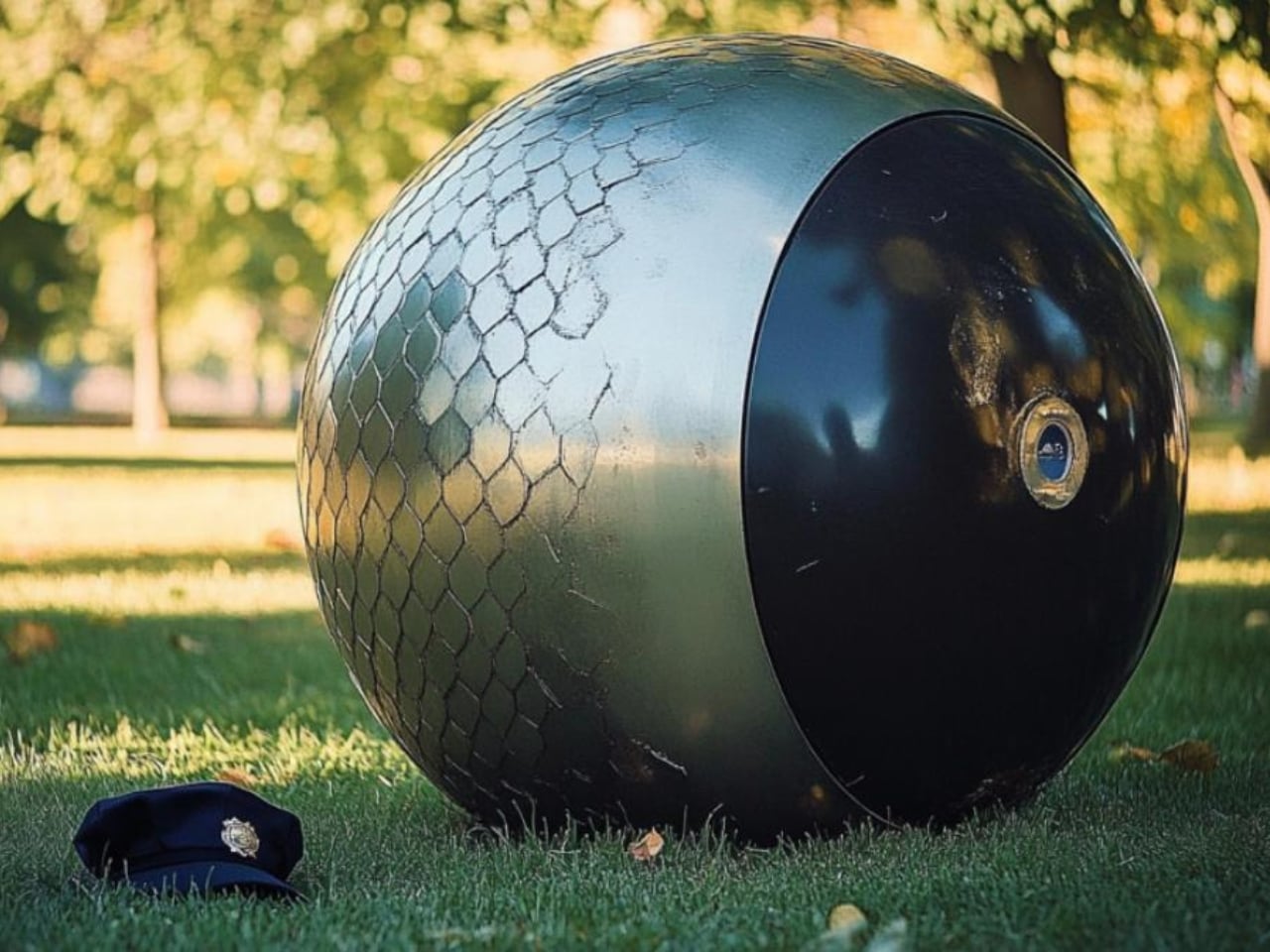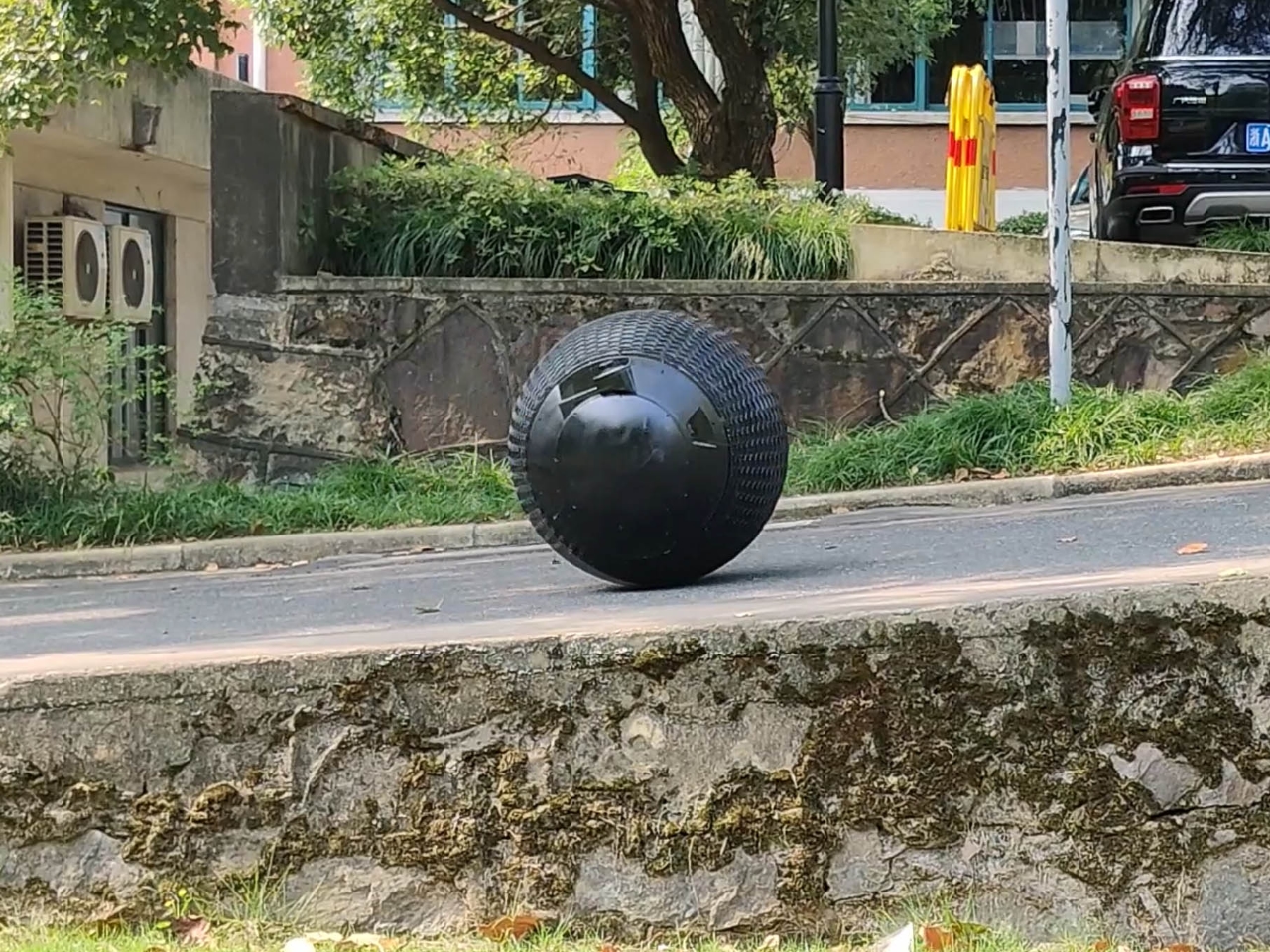In my recent Onewheel review on Yanko Design, I discussed how innovative personal mobility devices are reshaping our experience of travel and recreation. The Onewheel’s self-balancing technology, compact form factor, and intuitive design have allowed everyday users to experience smooth and surprisingly powerful rides across diverse terrains. It felt revolutionary—like a glimpse of the future of personal transport. Take that same spirit of innovation, self-balancing precision, and purposeful design, and imagine it transformed into a law enforcement tool straight out of science fiction. That’s precisely what China’s Rotunbot RT-G spherical police robot aims to accomplish: a next-generation patrol device that marries advanced mobility with frontier robotics.

Designer: Logon Technology
Bridging the Worlds of Recreational Mobility and Robotic Patrol
For many of us, the Onewheel was a revelation of how seamlessly technology can integrate with movement. By using a gyroscopic, self-balancing system, Onewheel riders can zip around sidewalks, streets, or off-road trails with a feeling of intuitive control. In my Yanko Design review, I highlighted its robust build, water-resistant electronics, and the uncanny sense of fluid balance that made riding it so addictive.

The Rotunbot RT-G is conceptually linked to the Onewheel on the design side, not by having a single wheel but by harnessing sophisticated gyroscopic stabilization to manage its spherical shape. If the Onewheel feels futuristic, the Rotunbot RT-G looks entirely otherworldly—like a robotic orb plucked out of a dystopian film. Yet, while the Onewheel was made for personal transportation, the Rotunbot RT-G addresses an entirely different challenge: automating certain aspects of law enforcement and emergency response.
The Rotunbot RT-G: A Futuristic Patrol Orb Straight Out of Sci-Fi
Developed by Logon Technology in China and currently trialed in Wenzhou’s commercial zones, the Rotunbot RT-G weighs 125 kg (276 lbs). The design is a perfect sphere outfitted with an internal gyroscopic mechanism that keeps it stable as it zips around. Unlike conventional patrol robots that run on wheeled platforms or treads, the RT-G can pivot in any direction seamlessly. While the Onewheel uses a single wheel to provide a skateboard-like feeling, the Rotunbot has its entire outer shell rolling, which is visually striking and functionally unique.

Speed and Acceleration
One parallel to the Onewheel is the emphasis on speed and nimble maneuvering. Depending on the model, Onewheel devices generally top out around 25 km/h (15 mph). The Rotunbot RT-G, on the other hand, can chase suspects at up to 35 km/h (22 mph)—even on water. It can achieve this top speed in just 2.5 seconds, which is remarkable for a 125-kg sphere. Rapid acceleration like this is critical in any law enforcement context, where seconds can mean the difference between intercepting a suspect or losing them. Its amphibious capabilities further expand its operational environment, letting it roll across muddy paths, slush, shallow water, and presumably even rain-soaked surfaces without losing balance.
China's police now have a new support: a spherical patrol robot that can hit 30 km/h in just 2.5 seconds. Inspired by a concept originally in Mercury probe project, this high-speed machine is ready to roll on both land and water. #FutureChina pic.twitter.com/q0sdEkYfxB
— China Xinhua News (@XHNews) December 14, 2024
Movement Mechanics
The Rotunbot uses an internal set of gyroscopes and stabilizers reminiscent of the sensor package in a personal electric unicycle or Onewheel. Think of it as a self-contained orb that remains upright from the inside, with the outer shell rotating around its stationary center. Unlike the Onewheel’s single, exposed tire, the Rotunbot’s entire hull is the “wheel.” Steering is achieved through subtle shifts in internal weights and torque distribution, somewhat like how you lean on a Onewheel to turn.
Crime-Fighting Features: An Orb of Non-Lethal Tools
Where the Rotunbot RT-G truly differentiates itself from a consumer product is in its arsenal of non-lethal law enforcement tools. The spherical orb can deploy tear gas, smoke bombs, net shooters, acoustic crowd dispersers, loud horns, and a sophisticated array of cameras and sensors. These non-lethal measures aim to provide crowd control, suspect immobilization, and broadcasting warnings or instructions.
The Chinese company #Logon Technology has recently presented the RT-G spherical police robot, designed to move both on land and in water and pursue criminals#Future #Prospective #humanity #NewWorld #robotic #TechTrends pic.twitter.com/ipxLohvF83
— AAMC (@docangelmtz1) November 13, 2024
On a personal mobility device like the Onewheel, sensors balance the rider and measure terrain conditions. On the Rotunbot, sensors extend beyond movement: multiple cameras track and identify threats, GPS navigation keeps it oriented, and ultrasonic sensors help it map the environment. Facial recognition software can identify known offenders or locate persons of interest. By enabling officers to operate remotely, these capabilities significantly enhance safety in hostile environments, keeping personnel out of immediate danger while maintaining situational control and efficiency.
Real-World Constraints: What Holds It Back?
Much like the Onewheel can’t climb flights of stairs or sharply pivot in impossibly tight spaces, the Rotunbot RT-G faces its own real-world limitations. The spherical orb falters when faced with abrupt elevation shifts, such as stairs or tall curbs. While a Onewheel rider might occasionally hop off and carry the board up a flight of stairs, you can’t just pick up a 125-kg robot. This severely limits the RT-G’s ability to pursue suspects into multi-level structures, subways, or areas with multiple flights of stairs.
While the RT-G achieves impressive top speeds, sharp turns can cause the orb to wobble or lose some stability. In a frantic pursuit scenario with quick direction changes—like weaving between narrow alleyways or pedestrian traffic—the Rotunbot might not be as agile as a sprinting officer or a suspect in a vehicle. Similarly, just like you’d have to plan your path on a Onewheel to avoid hazards, the RT-G’s spherical design must factor in potential tipping points or frictional issues.

Currently, the RT-G operates under remote human supervision, though future models may see increased autonomous capabilities. This is reminiscent of early consumer personal mobility devices, which initially required constant user control before advanced software improved their self-stabilizing features. Over time, lessons gleaned from real-world tests may lead to software improvements that allow the Rotunbot to handle more complex tasks independently. However, autonomy introduces a host of ethical and practical concerns when dealing with law enforcement. Questions about liability, hacking, target misidentification, and the deployment of force must all be carefully addressed.
Potential Applications Beyond Crime-Fighting
Much like the Onewheel’s technology can inspire other personal mobility devices (electric skateboards, self-balancing scooters, e-bikes, etc.), the Rotunbot RT-G’s spherical design could find utility in other fields. Disaster relief scenarios come to mind: an amphibious spherical robot might be able to roll through flood zones or collapsed buildings to locate survivors, transport supplies, or map debris fields. Environmental monitoring is another possible application—imagine these orbs measuring pollution levels in remote wetlands or patrolling coastlines for illegal dumping.

The RT-G’s design could be adapted for industries outside policing by swapping out its tear gas sprayers or net shooters for specialized tools like medical equipment or scanners. Its self-balancing, robust, amphibious mobility makes it a promising platform for countless future applications.
Future and Ethical Considerations
The Rotunbot RT-G represents a major step forward in robotic law enforcement, but it raises ethical and practical concerns. Balancing privacy, safety, and efficiency is complex in a system designed to watch, pursue, and potentially subdue individuals. Missteps in facial recognition, liability for autonomous decisions, and hacking threats must be addressed before widespread use. While it still faces real-world limitations—like stairs, sharp turns, and partial autonomy—ongoing improvements could make it lighter, more agile, and increasingly capable.

At its core, the RT-G shares a similar spirit with devices like the Onewheel, both harnessing advanced technology to reshape movement and mobility. Whether used to patrol streets or traverse flood zones, its innovative design demonstrates that technology continues to push boundaries, transforming how we interact with our surroundings. As these innovations progress, they highlight a profound shift in mobility and robotics, showing that creativity and practical engineering can redefine entire industries.
The post Rolling Crime-Fighting Machine: The Futuristic Robot Redesigning Law Enforcement first appeared on Yanko Design.
from Yanko Design

0 Comments